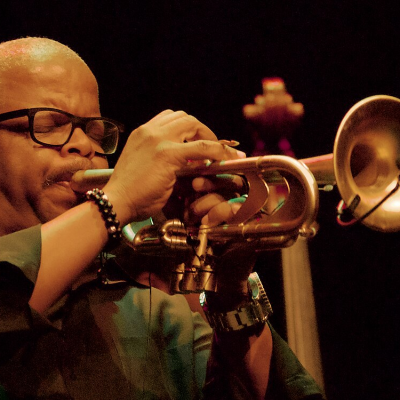
Robert Hecht, 1992
_____
The Sober Years
by Robert Hecht
From a small balcony above the stage of the Maybeck Recital Hall in Berkeley, I’m looking down on the jazz duo of bassist Red Mitchell and pianist Roger Kellaway, while tapping my foot to the earthy, swinging beat they are laying down.
It’s a Sunday afternoon in 1992 at this unique venue. The recital hall is part of a house originally built by the famed architect Bernard Maybeck in the early twentieth century. (Maybeck designed the Palace of Fine Arts in San Francisco, along with many other notable buildings in that city.) The hall accommodates only about 50 people, and it’s a warm, redwood-paneled room with beautiful leaded glass windows on three sides. It actually feels a lot like being in a little chapel—but the religion being worshipped here is that of acoustic jazz, primarily of the pianistic variety.
For several years now, ‘The Maybeck’ as it’s familiarly called, has hosted a who’s-who of world-class pianists. (Ultimately, between 1989 and 1995, Concord Records would release more than 40 albums recorded live here by the likes of Hank Jones, Marian McPartland, John Hicks, Cedar Walton, Alan Broadbent, and so many other great players.)
My friend Grover Sales, the noted author of Jazz: America’s Classical Music, has recently been hyping the piano playing of Roger Kellaway to me. “I won’t say he’s the greatest living piano player,” Grover is fond of saying, “I just don’t know anyone who’s better!” This kind of not-so-subtle statement is normal for Grover—he is nothing if not strongly opinionated. But he is also extremely knowledgeable about the music—he formerly was a publicity agent for Duke Ellington and Dave Brubeck—and has very good taste. He, too, of course, has come to the Maybeck today to hear Roger and Red. (Little do I realize, however, what a momentous day this will turn out to be for me.)
The album recorded at the concert Largely at Grover’s urging, I had also gone earlier this week to Yoshi’s jazz club in Oakland to hear this remarkable duo, and had been knocked out by them, so much so that I am back to hear more today in this lovely, intimate setting. They are certainly worth hearing twice in one week, as their musical rapport is simply astonishing—you can just see and hear how they listen and respond to one another, and they are clearly enjoying it all. As an additional bonus, the concert today is being recorded by Concord Records.
Both Roger and Red are consummate jazz masters with long careers. Red Mitchell is one of jazz’s premier bassists. He has played with almost everybody, including Gerry Mulligan, Billie Holiday, Stan Getz, Clark Terry and even Ornette Coleman. He also taught Scott LaFaro, the innovative bass player who revolutionized the instrument in the early sixties. Roger Kellaway is a noted New York-based pianist, who has played with Ben Webster, Sonny Rollins, Stan Getz and Sonny Stitt; he has also done some groundbreaking work with his own cello quartet.
Red does the talking between numbers, displaying his warm and witty personality. He has a unique way of combining humor and seriousness that is both charming and compelling. This is very evident as he begins a long spoken introduction to the next tune.
“For Roger and myself,” Red reflects, “these are the sober years.”
This gets my attention immediately, as they are in fact ‘the sober years’ for me as well, having gone into recovery two years earlier, after some thirty years of abusing drugs and alcohol.
“I don’t know if it’s the same for everybody,” Red continues. “But we’ve found that everything is just a little lighter and easier, sober. And we have a lot of friends who are in the same delicate condition,” he says to some knowing laughter from the audience.
Despite Red’s lighthearted approach to telling this story, it is clear he is as serious as your life. In the jazz world, substance abuse has almost been ‘de rigueur’ for musicians and has cost untold lives. Stories of jazz musicians and their use and abuse of drugs and alcohol are legion; sometimes these stories are told as cautionary tales, other times simply as sources of humor.
For example: “Did you hear the one about the two jazz musicians who walked past a bar? Well, it could happen….” (insert rim shot here).
Guitarist Eddie Condon was notorious for his alcohol abuse, and for his famous remedy for a bad hangover, which begins: “First, take the juice of two quarts of whisky…”
Here’s another: “Tenor man Al Cohn was visiting Denmark and a local asked him if he’d tried their famous Elephant Beer. Without missing a beat, Cohn replied: “No, man, I drink to forget!”
While this story humorously illustrates Cohn’s legendary quick-wittedness, the humor is easily diminished when you know that he would die some years later of liver cancer.
Cohn’s musical partner and fellow tenor player Zoot Sims was known for his great fondness for Dewar’s Scotch, often consumed in generous quantities on the bandstand. His beverage of choice was even memorialized in Dave Frishberg’s song, “Zoot Walks In” and the line:
“You’d better telephone home
and tell ‘em not to wait up,
then order double Dewar’s straight up.
Tell ‘em Zoot walked in,
and the band’s about to begin to swing now.”)
After one set of remarkable playing by Sims at the Half Note in New York City, matched by his remarkable consumption of whiskey, a fan approached and asked him: “Hey Zoot, how come you can play so great when you’re drunk?” Zoot answered, “Easy, man. I practice drunk.”
Okay, it’s funny, but humor aside, Zoot, too, would die too early of alcohol-related disease.
Alto genius Charlie Parker was famously known as the king of the junkies, whose gargantuan talent was matched by his prodigious capacity for heroin and booze. He frequently warned other musicians who mistakenly thought that his genius was somehow related to his being high but few listened, and many lives were ruined or cut drastically short as a result of that misguided thinking. Unsurprisingly, Bird’s life was truncated too—he was dead before reaching the age of thirty-five.
Simply put, addiction is a life and death matter. And in the jazz world it has at times been of epidemic proportions. (This reality is chronicled beautifully in Martin Torgoff’s book, Bop Apocalypse: Jazz, Race, the Beats, and Drugs.)
So today at the Maybeck we’re hearing a very serious spiel on addiction by Red Mitchell, but one nicely leavened with humor. And we are soon to see that Red is also using this story as a tongue-in-cheek way of introducing a Rodgers & Hart classic.
“We’d like to dedicate this tune,” Red says, “to everybody who has gotten over their ‘joneses’—you know, in the jazz world, we call a bad habit a ‘jones.’
‘You know so and so, does he drink?’ ‘Yeah he drinks but he doesn’t have a jones.’ ‘Does he smoke pot?’ ‘Yeah, he’s been smokin’ pot for thirty years but he doesn’t have a jones—he just really likes it!’
There is more laughter from the audience at Red’s sardonic humor. But, like the great jazz musician he is, he will take his time in getting to the punch line of his story.
I myself know all too well about having a jones, as substance abuse had long been a controlling factor in my life and often was the source of some very poor personal life decisions. Because, as the research shows, for someone like me with proclivities toward addiction, drugs can readily hijack the brain’s healthy reward system, easily convincing the user to pursue drug-seeking, even when the price of such pursuit is very high personal risk. You know, like the potential loss of everything important in your life….
So after decades on that not-so-merry-go-round, a couple of years earlier I had at last come to see the futility of that path, and had freed myself from that self-destructive syndrome, fundamentally changing the course of my life. With the help of twelve-step programs, I had recognized the truth in one of the many aphorisms quoted at meetings—that for an addict, “one is too many, and a thousand never enough.”
Meanwhile, back at the Maybeck, Red finally reaches the conclusion of his seemingly roundabout introduction to the tune:
“Anyway, we just changed the title of this tune, and it’s dedicated to all of our friends who have accomplished getting sober, and even those who didn’t, and are now somewhere else in the universe…”
Here Red pauses a beat for dramatic effect, then adds:
“…and it’s called, “Have You Missed Your Jones?”
This is met with uproarious laughter from the audience—including a very distinctive, loud guffaw from Grover—at which point Red and Roger launch into a swinging version of “Have You Met Miss Jones?”
……..
The truly momentous event that occurs on this day—May 31st, 1992—will profoundly affect the rest of my life. During the first half of the concert, from my balcony perch, my gaze is drawn repeatedly to an attractive woman in the audience below. I have been recently divorced but am not here with any plan to try to meet someone. However, I keep staring at this forty-ish blonde woman sitting down there not far from my friend Grover. I love the way she is bobbing her head and moving her body to the music, and I decide that one way or another I am going to meet her at intermission. Picking up women at concerts is not at all my standard ‘M.O.’ but I feel a strong attraction to this person and do not intend to miss the opportunity to see whether this attraction perhaps has some real potential.
When intermission arrives, I quickly move downstairs with the objective of introducing myself. I have no idea what I might say, but my confidence is high that I will figure it out.
However, I then see that she has already gotten in line for a glass of wine, and realizing it would be better not to hit on her in such an exposed situation, I decide to wait until she is free. In the meantime, I run into Grover, and he and I stand and chat about the wonderful music we have just heard. But all the while I am talking with him, out of the corner of my eye I keep glancing over to see when the time will be right to make my move.
A couple of minutes later I notice she is walking in our direction. I get ready to jump.
But then, miracle of miracles, she walks right up to us and greets Grover, who hugs her warmly and says, “Bob, do you know Dale Miller?” We shake hands—she has a good strong handshake—and we begin talking. I can hardly believe my good fortune—“Maybe there is a God, after all,” I’m thinking to myself. We seem to have an immediate rapport, and she tells me she’s taken many of Grover’s jazz appreciation and history classes at San Francisco State.
Within just a few moments, Grover leaves us alone to talk, likely sensing our attraction and chemistry. We chat for a while about the music and about our mutual friend. Grover is infamous for his often controversially outrageous pronouncements about music, race and politics, and I ask Dale if he is that way in his classroom setting as well. “Oh yeah,” she says with a big smile, “he doesn’t hesitate to say absolutely anything that’s on his mind, whether or not it’s politically correct.”
And at that moment, picking up on her comment like a jazz musician might pick up on a passing phrase from a fellow musician, I spontaneously come up with one of my best lines ever, saying, “Well, speaking of not hesitating—can I call you?”
She laughs (what a terrific laugh she has), and to my great joy, she writes down her phone number for me. Then it is time to return to our seats for the second half of the concert, although during the music I can hardly keep my eyes off her, occasionally feeling the piece of paper in my pocket with her phone number on it.
There is not another opportunity to talk after the concert, but the very next morning I call her and we arrange a dinner date. I also get her address and put in the mail a ‘mix tape’ I have made for her the previous evening after getting home from the concert. Naturally, it is of recordings by Roger Kellaway and Red Mitchell.
From that day onward, there is not a single day in which we do not communicate. I mean, not a single day from that day until the present! We soon become lovers, best friends, life partners and even business partners, and eventually husband and wife. As of this writing in 2018, we are now in our twenty-seventh year of what is, I’m quite sure, one of the most compatible, harmonious and loving relationships in the history of human pairings.
Grover Sales speaking at the wedding In 1998, six years to the day of our first meeting, on a Sunday afternoon in a friend’s gorgeous garden in Marin County, we are married. Grover is one of the speakers at the ceremony, and in true Grover form, after first acknowledging the wonderful serendipity of the bride and groom meeting on that life-changing day at the Maybeck, he then begins to veer off on a lengthy jazz tangent, talking about how overlooked and under-appreciated both Red and Roger sometimes are in critical jazz circles! Eventually he gets back on point—perhaps remembering that this day, after all, is about us, not about those great musicians or the unfairness of the vagaries of jazz popularity.
In the years that follow, Grover always proudly takes full credit for introducing us, and I never have the heart to tell him that one way or another I was going to meet Dale that day, even without his help, and that really all he did was grease the skids. Although, upon reflection, perhaps his introduction really did make the critical difference in our meeting, and it’s certainly indisputable that without his enthusiastic cheerleading for those musicians, we would not both have been in that place at that time.
So—much gratitude to you, Grover…and thank you as well, Red and Roger.
…….
Just five months after this concert, the news came through that Red Mitchell had died as the result of a stroke at age of 64. Grover would live until nearly twelve years later.
As of this writing, in 2018, I’ve been sober for 28 years. So these are, indeed, the sober years for me, as well. And as Red rightly noted, things definitely seem “lighter and easier.”
_____

Robert Hecht is an award-winning jazz disc jockey and fine art photographer whose photo work has been published in LensWork, Black & White, Zyzzyva and The Sun and exhibited internationally. His writing has previously appeared in LensWork and in the haiku journals Frogpond, Bottle Rockets and Modern Haiku. He and his wife live in Portland, Oregon. For twenty-five years they have been partners in On Point Productions, writing and producing marketing and training video programs. Visit his website by clicking here.
*
Have a memorable jazz story you would like to share? Submit it for consideration at [email protected]


































